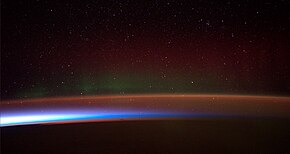
Back توهج ليلي Arabic Airglow Catalan Světelné záření atmosféry Czech Nachthimmellicht German Ατμοσφαιρική φωταύγεια Greek Luminiscencia nocturna Spanish هواتاب FA Ilmahehku Finnish Lumière du ciel nocturne French זוהר לילי HE


Airglow (also called nightglow) is a faint emission of light by a planetary atmosphere. In the case of Earth's atmosphere, this optical phenomenon causes the night sky never to be completely dark, even after the effects of starlight and diffused sunlight from the far side are removed. This phenomenon originates with self-illuminated gases and has no relationship with Earth's magnetism or sunspot activity.
- ^ "Austrian Software Tools Developed for ESO". www.eso.org. European Southern Observatory. Retrieved 6 June 2014.